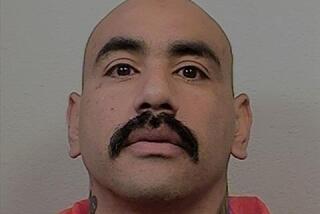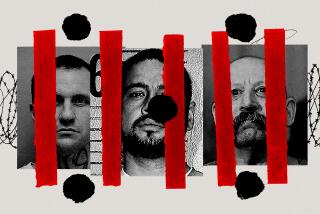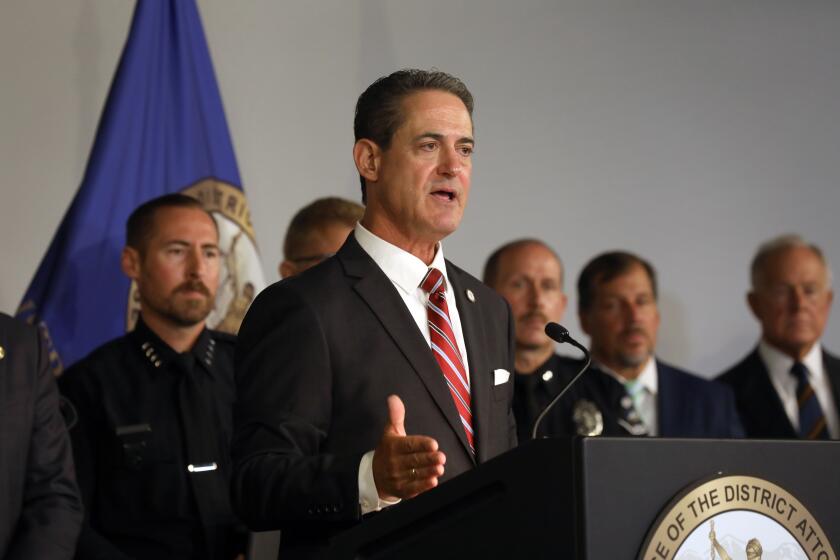L.A. gang leader called ‘monster,’ sentenced to death
Even in a city with more than 150 gang slayings a year, Timothy Joseph McGhee’s murders stood out.
For years, authorities say, McGhee waged a campaign of terror in the northeastern part of Los Angeles. A shot-caller for a long-entrenched gang, he hunted rivals but sometimes killed indiscriminately, boasting in rap lyrics about the pleasure he felt in taking life.
He taunted law enforcement and led a sophisticated ambush that ensnared two Los Angeles Police Department officers in a barrage of gunfire. While locked up, he incited jail riots and assaulted guards, responding to one attack in which an officer survived by saying, “Next time I’ll have to stab him.”
On Friday, McGhee, once one of the nation’s most sought-after fugitives, sat shackled in orange jailhouse scrubs as Superior Court Judge Robert J. Perry sentenced him to death for the murder of three people.
Slim, with a shaved head adorned with a tattoo of an eagle eating a snake, McGhee showed no emotion as the judge said the 35-year-old treated killing “as some kind of perverse sport, as if he was hunting human game.”
Perry said he accepted defense arguments that McGhee’s father abandoned him as a young boy and that McGhee was nevertheless a good father to his children and the children of his girlfriend. But the judge said he believed execution was the appropriate punishment.
“He is a committed killer and an obvious danger to society,” Perry said.
Police and prosecutors described McGhee as a thrill killer who was among the most feared members of the Toonerville gang, which was formed in the 1950s and claims as its turf a largely middle-class area north of Los Feliz Boulevard between San Fernando Road and the Los Angeles River.
To convict McGhee, prosecutors relied heavily on former gang members, including accomplices in the slayings, as well as other witnesses and ballistic evidence.
Several witnesses were relocated for their safety. Others had to be ordered to testify.
Once they confronted McGhee in court, some rival gang members backed away from statements against him that they had given detectives.
During the death penalty phase of the trial, the prosecution presented evidence that McGhee was involved in a fourth murder -- the execution-style killing of a friend, Christina Duran, who had told police about his involvement in a killing.
Duran’s videotaped interview with LAPD detectives helped convict McGhee of the 2001 murder of Margie Mendoza.
Mendoza, 25, was fatally shot while McGhee and his associates prowled the streets to avenge the killing of a comrade hours earlier. Mendoza’s boyfriend -- who belonged to a rival gang -- and another woman were wounded in the attack.
Prosecutors said McGhee dropped his girlfriend’s cellphone at the scene and asked Duran to help him retrieve it. A neighbor who witnessed the assault also recalled that one of the gunmen had a distinctive tattoo of an eagle eating a snake on his shaved head.
Jurors also found McGhee guilty in the murders of Ronnie Martin, 25, a rival gang member who was shot 28 times in 1997, and Ryan Gonzalez, a 17-year-old member of another gang, who was killed in 2000.
“The one quality that I have seen in him that I have not seen before is a quality that is more typical of a serial killer: They enjoy killing,” said Deputy Dist. Atty. Hoon Chun. “He seemed to enjoy killing.”
Defense attorneys H. Clay Jacke II and Franklin Peters Jr. argued that some witnesses involved in the crimes had tried to emphasize McGhee’s role in order to minimize their own. The attorneys said they disagreed with the judge’s decisions to allow jurors to see Duran’s videotaped interview with police and to remove a juror during deliberations who favored the defense.
“We’re hopeful that this is not the final chapter,” Peters said after Friday’s hearing. McGhee, they said, would appeal.
Police suspect that McGhee took part in or ordered other slayings, including the September 2000 shooting of a 17-year-old boy who was sketching a picture at the Los Angeles River and the death of a homeless man who might have witnessed the shooting.
Prosecutors initially charged McGhee with nine murders but dropped six counts before trial, citing an unreliable witness.
Authorities said McGhee showed sophisticated tactical awareness in planning attacks.
In the predawn hours of July 4, 2000, prosecutors alleged, McGhee used a police radio scanner to track the progress of LAPD officers Thomas Baker and Carlos Langarica as they chased three Toonerville members into the heart of the gang’s turf in Atwater Village.
Gang members threw a washing machine and a bicycle into the road, causing the cruiser to swerve toward two gunmen waiting in the dark. Bullets struck the car. One tore a hole in Baker’s pants, but neither officer was injured.
“I thought that I was going to get shot and killed,” said Langarica, who now teaches in the department’s academy.
Prosecutors argued that McGhee was one of the gunmen. Jurors convicted him of attempted murder of both officers.
After McGhee disappeared in late 2001, his name was added to the U.S. Marshals Service list of most-wanted fugitives. He was captured in February 2003 in Bullhead City, Ariz.
At the home of his girlfriend, police found a notebook of rap lyrics belonging to McGhee. In one song, titled “Here I Come,” McGhee wrote: “Here I come, last chance to run. Killer with a gun, out to have some fun. In my dreams, I hear screams. Pleasure I feel is so obscene.”
Once behind bars, authorities said, McGhee continued his violence.
Prosecutors said he twice instigated riots, inciting inmates on one occasion to break up their sinks and throw pieces at Sheriff’s deputies. On four occasions, Sheriff’s deputies discovered razors or other metal objects hidden in his cell.
Chun, who prosecuted the case, said McGhee was intelligent and showed an unusual talent in writing lyrics.
“This is not someone who is a typical gang member,” Chun told the court. “He could have used that to influence people for the better. But he did the opposite.”
--
More to Read
Sign up for Essential California
The most important California stories and recommendations in your inbox every morning.
You may occasionally receive promotional content from the Los Angeles Times.











